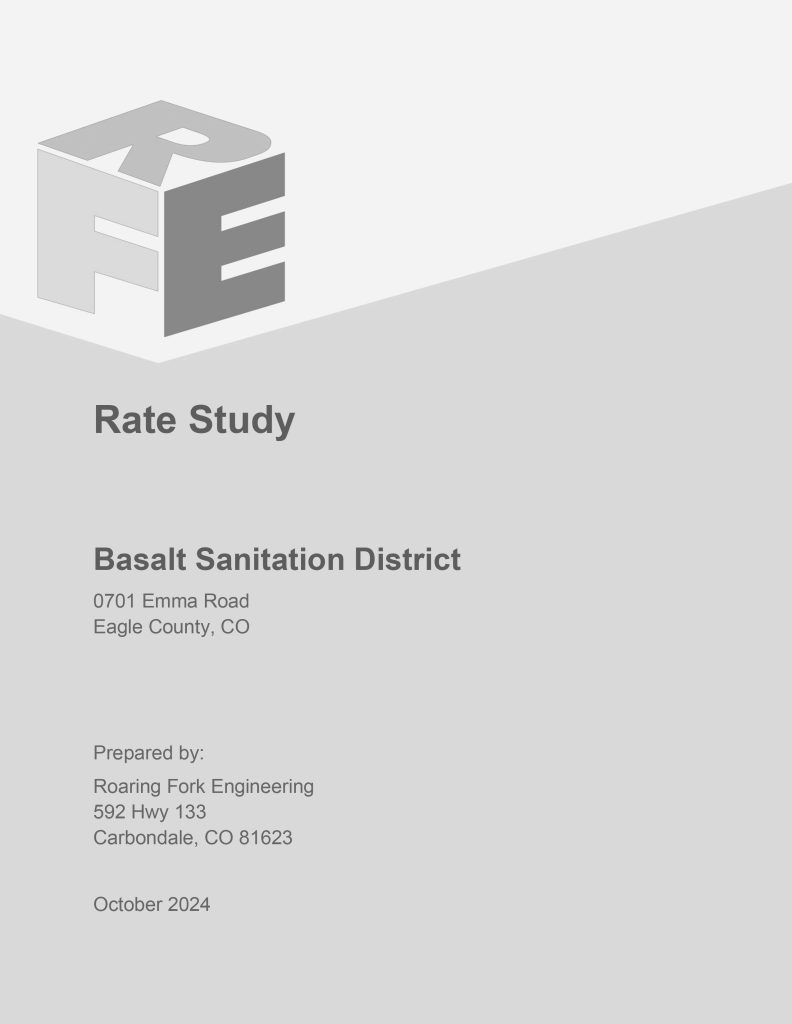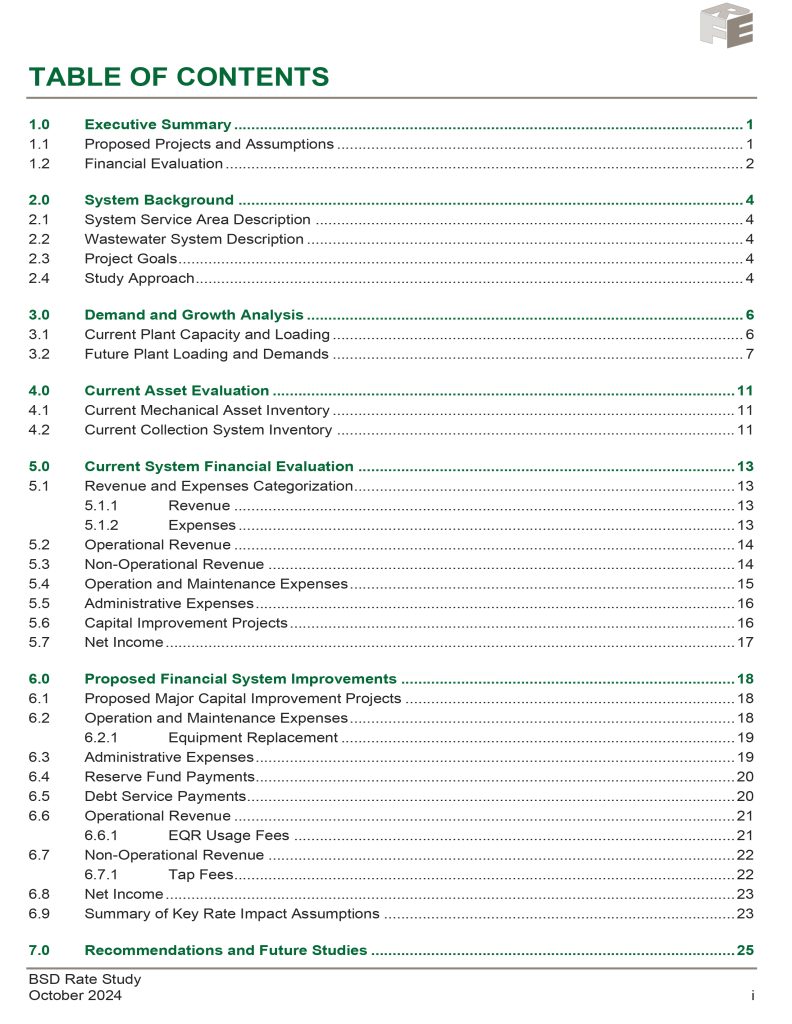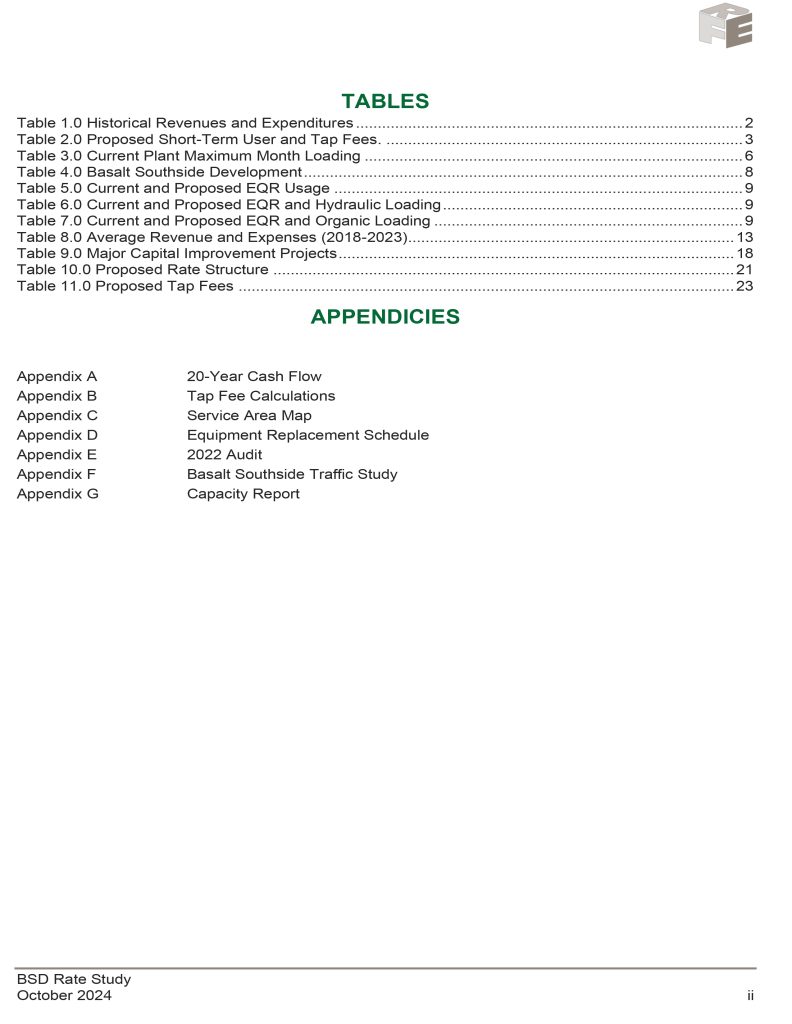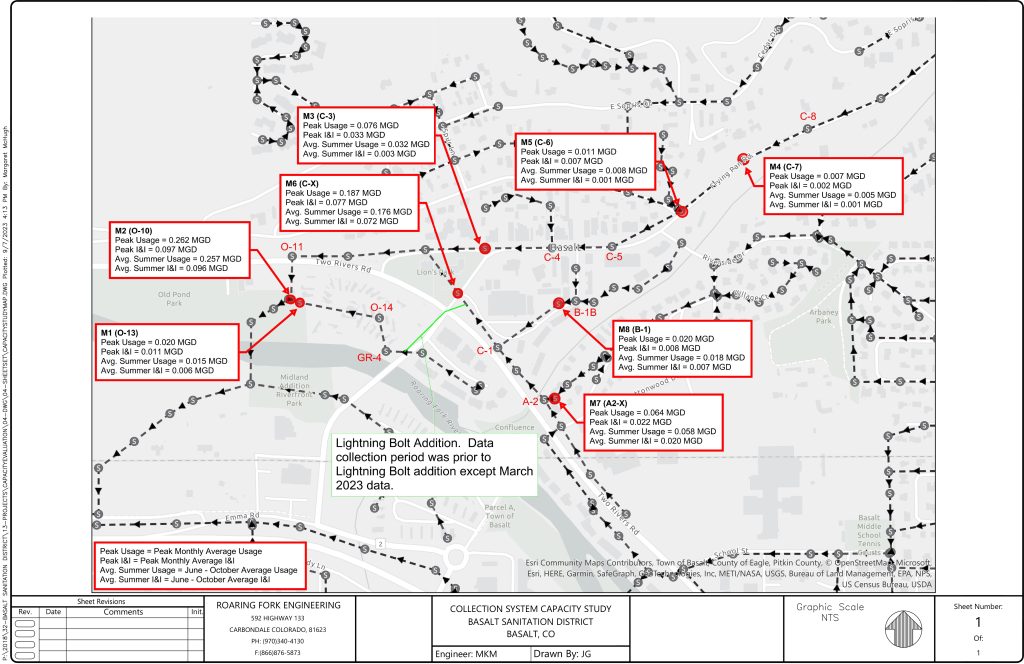A sewer rate study is a comprehensive financial and technical evaluation performed by a wastewater utility to project future costs and revenues. These studies are conducted by licensed engineers employed by the municipality or Special District, or contracted out to a professional with the ultimate goal of setting fair, sustainable, and legally-defensible user fees.
In essence, the study determines how much money the utility needs to run its system effectively and then allocates those costs equitably among all different types of customers. The total amount of money needed is called a “revenue requirement,” and the study typically forecasts financial needs over a long-term period, anywhere from ten to twenty years.
This comprehensive document is substantial. For example, a recent sewer rate study we performed for Basalt Sanitation District in Basalt, Colorado is 99 pages long. You can see from this sample below with the table of contents how thorough it is.



Simply put, a sewer rate study is a thorough, deep dive into the sewer infrastructure and finances. In this article, you’ll learn about:
- Sewer rate studies in Colorado
- Purposes of a sewer rate study
- When sewer rate studies are required
- What a sewer rate study includes
- Who should be responsible for the sewer rate study
Sewer Rate Studies in Colorado
Colorado’s sewage collection and transmission systems are subject to additional strain and higher costs due to geographic and environmental factors.
Rugged, mountainous terrain and remote locations can make the initial construction and ongoing maintenance challenging due to accessibility. These conditions also present engineering challenges with steep slopes, rocky surfaces, groundwater infiltration, and unpredictable weather.
In addition, many mountain communities in Colorado have older infrastructure, simply due to the fact that it’s expensive and challenging to maintain. This necessitates large replacement projects to update facilities before they deteriorate. Sewer rate studies help plan for these expenses to ensure no catastrophic failures or unexpected expenses.
Purpose of a Sewer Rate Study
Sewer rate studies are designed to protect the long-term health of a sewer system and establish a reliable, cost-based revenue stream. This is vital — without accurate rate studies, funds may not be sufficient to cover emergencies or repairs, maintenance plans may be deferred, and costs to the public will rise.
Sewer systems are a pillar of a clean, safe community. Rate studies are an essential part of keeping them in good standing. Here are the four main purposes of a sewer rate study:
Financial Sufficiency
A sewer rate study determines the total revenue required to cover all expenses to keep the sewer system running. This includes routine operations and maintenance, debt service, and cash reserves for emergencies.
An all-in picture of total cost ensures the utility company can make sure they have their finances in order to ensure the long-term health of the sewer system.
Capital Funding
A sewer rate study will indicate what funds are needed for planned capital improvements. Capital improvements include projects that increase the property value and useful life, so for a sewer system, this includes upgrading aging infrastructure or replacing mechanical equipment as needed to ensure lines, lift stations, and treatment plants are in good working order.
Equity and Cost of Service
A sewer rate study provides information that helps to set rates for each customer class — including residential, commercial, and industrial users. The study will define each customer class’s burden to the system, like flow volume and pollutant strength, and determine costs accordingly.
Transparency and Compliance
Finally, sewer systems are a vital public health system and require transparency to build trust in the public. Regular sewer rate studies justify the rates to the public and governing body, ensure compliance with state regulations, and promote efficient resource management.
When Is a Sewer Rate Study Needed?
Typically, sewer rate studies are needed every three to five years to keep up with fluctuating costs, changing economic conditions, and regular maintenance requirements. In specific circumstances, they may need to happen more often.
If the utility company plans to take on new debt, a sewer rate study may be required to demonstrate financial soundness. If the current rate structure is not meeting needs, a rate study may be scheduled to understand why and help resolve growing deficits or depleting cash reserves.
Finally, if a large capital improvement project is planned, a rate study will likely be planned to account for the costs of the project and how they will affect the existing rate structure.

What a Sewer Rate Study Includes
Sewer rate studies are typically broken into three phases:
Financial Planning
The first step includes financial planning to calculate the revenue requirement. The engineering firm or consultant responsible for the sewer rate study will analyze historical data, project future expenses, and determine the revenue needed to meet those goals.
The output of this step is a total amount of revenue, called the Net Revenue Requirement, that must be collected from customers via rates over the study period, such as five years. This calculation subtracts non-rate revenue like investment income or grants from the total costs.
Cost Allocation
The next step includes determining what it costs to serve each customer group. To complete this, costs are allocated to different system functions such as collection, pumping, and treatment, and then distributed to customer classes based on their specific usage characteristics — particularly flow volume and waste strength.
The output of this step is a required revenue target for each customer class, ensuring all costs are proportionately recovered.
Rate Design
The final step is to structure rates so the wastewater utility company can collect the required revenue equitably. In the United States, private companies may run the collection and transmission systems, but the work is contracted out on behalf of the municipality or Special District.
This includes developing the rate structure, which typically begins with a fixed service fee to cover readiness-to-serve costs and a volumetric charge based on metered water consumption that reflects sewer usage.
The output of this step is a proposed schedule of new rates, fees, and charges, along with an impact analysis showing how the new rates will affect a typical customer’s monthly bill.
Who Conducts Sewer Rate Studies?
Specialized engineering firms are typically contracted to conduct sewer rate studies on behalf of the local government. There are well-established guidelines that govern sewer rate studies, and it’s important that the consultant you choose understands and adheres to these standards, although they are generally presented as authoritative recommendations rather than mandatory, prescriptive “standards” like those for pipe materials.
These include AWWA (American Water Works Association) and WEF (Water Environment Federation). The AWWA establishes generally accepted standards for setting rates, while the WEF offers guidance for specialized costs around pollutants and infiltration.
Civil engineering firms that offer environmental and water resource engineering, like Roaring Fork Engineering, have the right combination of specialized knowledge, practical skills, and technical expertise to complete these studies efficiently and accurately. Our services adhere to AWWA and WEF standards, and our capable team takes a holistic and comprehensive approach informed by decades of experience.. For reliable studies from an easy-to-work-with team, schedule a free consultation to learn more about our civil, environmental, and water resource engineering services. Get in touch today.